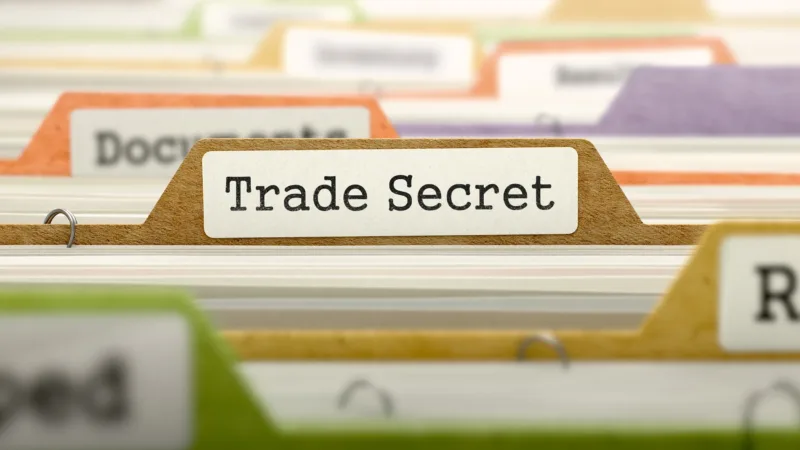Trade secrets, and their associated value, are an understated facet of commercial activity. The intellectual property owned and protected by businesses carry with them enormous economic weight and are often the target of inappropriate corporate activities such as espionage and theft. Too often, these pieces of property are insufficiently protected, misunderstood, and do not get the attention they deserve. As such, trade secret litigation has evolved into a niche, but growing area of law practice.
Below, we will explore some of the key elements of trade secret litigation, its scope and magnitude, distinctions between trade secrets and other types of intellectual property, as well as several other important considerations.
Trade secrets: The nuts and bolts
What defines a trade secret can vary by jurisdiction, but some examples of secrets include customer and supplier information, marketing strategies, new business models, and other types of confidential information one would generally not want their competitors to know.
Trade secret litigation can take a number of forms. Generally, these cases are adjudicated in civil court, but there are certain instances where stealing protected information could be a criminal matter. According to the Economic Espionage Act of 1996, stealing trade secrets can be prosecuted as a state and federal crime. The acts of copying and receiving trade secrets also fall under the act’s purview.
Individuals convicted of violating the Economic Espionage Act could face up to a $500,000 fine and ten years of prison time. Corporations found to be in violation of the act face even steeper penalties—fines for corporate entities can be as much as $5 million—and stolen secrets and property may be seized by the government.
Broadly speaking, the fiscal impact of cases dealing with the subject matter can be rather sizable. A recently published trends report found federal cases pertaining to trade secret disputes in 2020 yielded an astonishing $3 billion in damages, and each of the five largest awards included in the study topped $100 million. Interestingly, 68% of all cases included in the study were found to swing in favor of the plaintiffs.
Additionally, the litigation was often more complex and nuanced than one might expect; nearly half of those cases involved multiple types of secrets included in the complaints. The information technology, healthcare, and consumer discretionary industries, in particular, have been identified as areas with a rising amount of litigation.
There are several key elements to consider when developing a plan to shield valuable intellectual property like trade secrets. Here we will explore what constitutes a trade secret and how those elements interact and overlap with various pieces of relevant legislation.
What are the 3 components of a trade secret?
For a piece of intellectual property to be considered a trade secret for litigation purposes it must meet three criteria from the United States Patent and Trademark Office (USPTO). Those three elements are as follows:
- The information must have either “actual or potential independent economic value by virtue of not being generally known;”
- It must have value to other individuals who cannot “legitimately” obtain it; and
- It must be subject to “reasonable efforts” to maintain the secrecy of that information.
In order for trade secret litigation to be initiated, all three elements must be present. If any one of those three elements are missing, the piece of intellectual property is deemed outside the category of a protected trade secret.
What law governs trade secrets?
As mentioned above, the Economic Espionage Act of 1996 is one of the major pieces of legislation to govern trade secret litigation. However, it is not the only such piece of legislation. The Defend Trade Secrets Act of 2016 also plays a large role in shaping trade secret litigation.
- Economic Espionage Act of 1996- This act criminalizes trade theft under two unique sets of circumstances, per information from the USPTO. As such, economic espionage occurs when a trade secret is stolen “intending or knowing that the offense will benefit any foreign government, foreign instrumentality, or foreign agent.”
Secondly, if the theft is “related to a product or service used in or intended for use in interstate or foreign commerce, to the economic benefit of anyone other than the owner thereof, and intending or knowing that the offense will, injure any owner of that trade secret,” it will also fall under the purview of the law.
- Defend Trade Secrets Act of 2016- This law amended the 1996 act to include a private cause of action with respect to the misappropriation of trade secrets. To that end, intellectual property owners protecting such secrets were able to establish a “uniform, reliable, and predicable way” to do so in a civil setting. Further, the law does not preempt other relevant laws and thus gives owners another avenue to pursue such litigation in federal or state venues.
In order to protect trade secrets, U.S. courts have a number of tools in their respective boxes. They could order any misappropriations halted, shield the secret from unwanted public exposure, and in extreme instances the secret itself can be the subject of a government-ordered seizure.
Once a trade secret case is concluded, there are several potential outcomes depending on jurisdiction. Those outcomes include damages, reimbursement for court costs, permanent injunction, and reasonable attorney’s fees.
Starting a claim: Trade secret misappropriation
Attorneys looking to take legal action regarding allegations of improperly proliferated intellectual property need to account for three critical elements. Those elements, according to the Legal Information Institute, are as follows:
- The subject matter of the secret in question must fall into the defined category of trade secret protection;
- The holder of said subject matter is required to establish “reasonable” precautions were taken in order to prevent the disclosure of said subject matter; and
- The holder must also prove the information was “misappropriated or wrongfully taken”
Additionally, it is important to remember trade secrets may be obtained lawfully. For example, if the secrets were obtained through the processes of reverse engineering, independent discovery, or inadvertent disclosure due to the holder’s failure to take requisite protective action, then allegations would be unable to proceed. In other words, individuals who can recreate or replicate a piece of intellectual property or obtain information about it that was never properly protected in the first place would not be violating any laws.
What happens when a trade secret is breached?
When a trade secret is improperly taken, the owner of that secret has several important decisions to make. In many cases, owners will request a court ordered injunction to prohibit any further disclosure of their intellectual property as one of the first steps in a trade secret dispute. The owner of the trade secret can also attempt to recover any financial losses incurred as a result of the purported breach through additional legal action.
Each state has its own procedures for adjudicating trade secret disputes. For example, in Texas, a plaintiff can file for a preliminary injunction under the Uniform Trade Secrets Act. In those instances, a preliminary injunction will be issued so long as the plaintiff can show that, first, the defendant possesses the intellectual property, and second, the defendant has the opportunity to use said information.
The remedies to these breaches will vary depending on what state they take place, and whether or not the secrets were applied for use in either interstate or foreign commerce. Should they have those components, the above-mentioned Economic Espionage Act will be considered when determining remedies.
How much does trade secret litigation cost and how long will it take?
Trade secret litigation can be a lengthy, costly endeavor. A 2019 report from the American Intellectual Property Law Association estimated the median cost to litigate cases involving financial risk between $10 million and $25 million was $4.1 million. When the financial risk pushed passed $25 million, that figure nearly doubled to $7.5 million.
In most instances, both parties are expected to pay for their own court costs and fees. There are certain exceptions laid out in the Uniform Trade Secrets Act that allow for the prevailing litigant to recover “reasonable attorney’s fees” in order to help deter malfeasance.
Attorney’s fees are eligible to be recovered when:
- A misappropriation claim is made “in bad faith;”
- A motion to terminate or an injunction is made “in bad faith;” or
- “Willful and malicious misappropriation exists.”
Similarly, the Defend Trade Secrets Act will also provide for an award of attorney’s fees under those same conditions. In a state like New York, which does not have its own trade secrets statute, it can be more difficult to recover attorney’s fees. There, all trade secrets protections come from common law, and individuals have three years to bring any alleged misappropriations to the court, according to information from the New York City Bar Association.
Not only are the costs associated with these cases noteworthy, so too is the amount of time they take to litigate. Cases can often take several years to adjudicate as federal lawsuits of that kind have been shown in a recent study to last an average of 2.7 years. In 2014, the length of those cases peaked dramatically at 4.5 years of litigation.
Trade secrets litigation: A case study
Trade secrets litigation happens all the time, and the stakes of those cases can be quite high. For example, one recent case out of Greeneville, Tennessee, involved a Chinese chemist who was charged with taking valuable proprietary information from soda manufacturer Coca-Cola. That case involved the theft of information regarding bisphenol-A-free (BPA-free) beverage can coatings used by the soda giant.
As such, in May, the U.S. Department of Justice (DOJ) announced the sentencing of Xiaorong You, who has been ordered to serve 14 years prison time for committing economic espionage, fraud, and trade secret theft. She was also ordered to pay $200,000 in fines, and she will be subjected to three years supervised release once out of prison.
Per the DOJ, You stole the trade secrets while working at a soda factory in Atlanta and the Eastman Chemical Company in Kingsport, Tennessee. The proprietary information she improperly obtained cost $120 million to develop.
Ultimately, You planned to use the data to start her own BPA-free company in China. As part of her plan, she received millions of dollars from the Chinese government via grant allocations in order to set up the company.
“As the evidence at trial showed, the defendant stole valuable trade secrets and intended to use them to benefit not only a foreign company, but also the government of China,” said Assistant Attorney General Matthew G. Olsen of the Justice Department’s National Security Division.
Other intellectual property considerations
Trade secrets are among several types of intellectual property. Other forms of property include patents, copyrights, and trademarks. Here we will briefly explore the differences between those forms of intellectual property.
Patents– These are government-sanctioned monopolies that allow individuals to create, sell, and use an invention. In general, patent protections last 20 years, although some forms of patent protection expire before that at 15 years. Additionally, patents will only be granted if they pertain to a new, useful, and non-obvious idea that falls within the court- and congressionally-defined definition of “patentable.”
Trademarks– A trademark is a word, symbol, phrase, design or combination of those elements identifying a service or a good. Trademarks help consumers identify the source of a given item or service, provide a measure of legal protection for one’s brand, and serve as a safeguard against fraud and counterfeiting.
Copyrights– These are used to protect works produced by authors, artists, photographers, musicians and other creative producers. Copyrights are used to protect expression, but do not extend to ideas, methods, concepts, procedures, systems, principles, or discoveries.
Trade secret protection does share some similarities and overlap with patent protections, but the two also have some key differences.
Trade secret protection goes hand-in-hand with patent protection. Patents usually require the inventor to itemize a detailed disclosure related to their invention in exchange for the ability to exclude other individuals from practicing with it for a certain period.
According to the USPTO, “Patents expire, and when that happens the information contained within is no longer protected. However, unlike trade secrets, patents may protect against independent discovery. Patent protection also eliminates the need to maintain secrecy.”
Simplifying the complex
Trade secrets litigation can prove challenging due to the length of time it takes to adjudicate, its prohibitive costs, and the complicated nature of intellectual property. The litigation process requires a high degree of expertise in specific subject areas.
That said, there are ways to make the process more cost-efficient and less complex. The use of technology can improve a plaintiff’s research, speed up discovery, and enable attorneys to craft a more compelling and thorough argument in court. A service like Practical Law is an all-in-one tool with practicing attorney-editors offering expert guidance to help you through a patent litigation case.
These resources include valuable checklists, model clauses and other relevant documents, practice notes, and a database of comparative summaries and myriad precedents pertaining to intellectual property and technology license agreements.
Preparation and planning are the key to winning any legal dispute, and with these resources you can be confident you are tackling your work with the most up-to-date, relevant, and effective research available.







